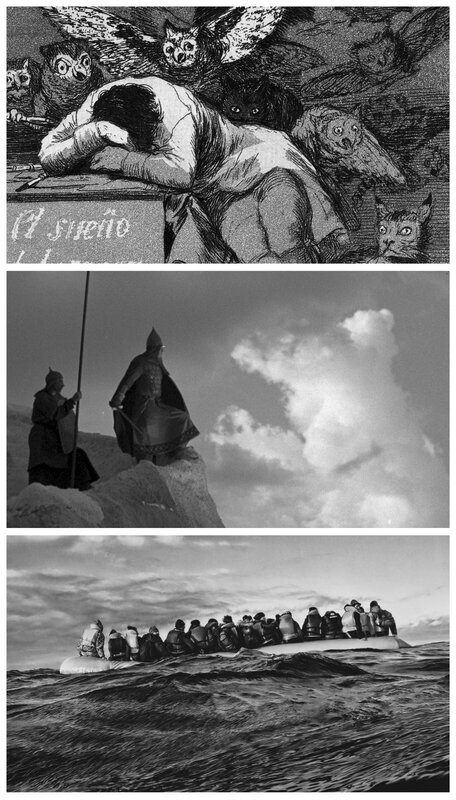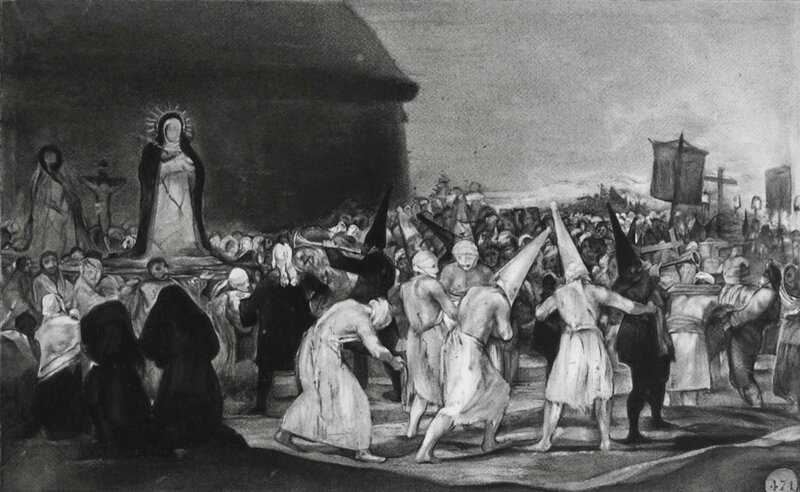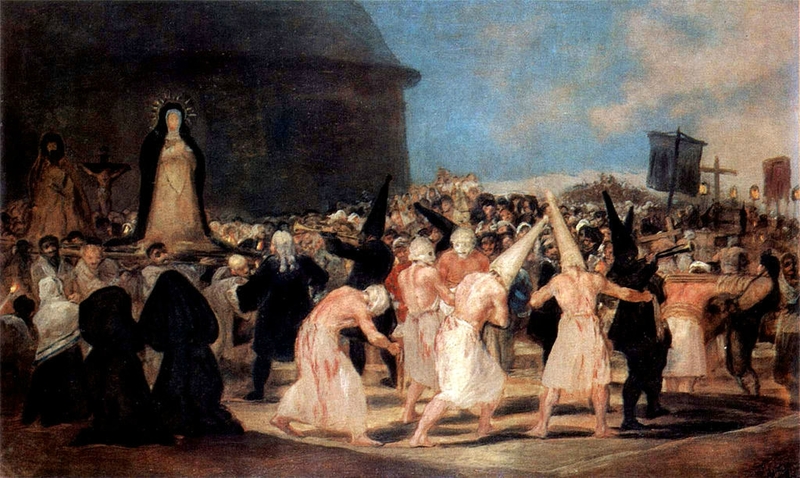Exhibition brings together three unsparing chroniclers of their time
Details: Francisco de Goya y Lucientes (Spanish, 1746–1828). The Sleep of Reason Produces Monsters (reproduced in black and white), from The Caprices (Los Caprichos), 1797–98. Brooklyn Museum; A. Augustus Healy Fund, Frank L. Babbott Fund, and Carll H. de Silver Fund, 37.33.8. (Photo: Jonathan Dorado, Brooklyn Museum); Sergei Eisenstein (Russian, 1898–1948). Still from Alexander Nevsky, 1938. Gosfilmofond (National Film Foundation of Russian Federation); Robert Longo (American, born 1953). Untitled (Raft at Sea), 2017. © Robert Longo, Private European Collection. (Photo: Courtesy of the artist and Metro Pictures, New York).
BROOKLYN, NY.- Throughout history artists have used their artwork to reveal social, cultural, and political complexities, responding with urgency and conviction to the repercussions of revolution, war, and civil unrest. From September 8, 2017, through January 7, 2018, the Brooklyn Museum presents Proof: Francisco Goya, Sergei Eisenstein, Robert Longo, an exhibition spanning three continents and four centuries that brings together the striking work of three unflinching chroniclers of their times. Depicting in black and white the societal impact of politics and power, the selections for this exhibition are presented in an inventive way that encourages a fresh evaluation of Goya and Eisenstein, while showcasing new works by Longo, who cites both of his predecessors as major influences.
Proof features a rare combination of works: 39 prints from Goya’s four major print series, including 14 from the Brooklyn Museum’s set of the Los Caprichos series, a masterpiece of satirical etchings; seven films by Eisenstein; and more than 20 large-scale charcoal drawings by Longo from the last decade, including three that have never been on public view.
Francisco de Goya y Lucientes (Spanish, 1746—1828). They Carried Her Off! (Que se la llevaron!), plate 8 from The Caprices (Los Caprichos), 1797–98. Etching and aquatint on laid paper, 81/2 x 6 in. (21.7 x 15.2 cm). Brooklyn Museum; A. Augustus Healy Fund, Frank L. Babbott Fund, and Carll H. de Silver Fund, 37.33.8. (Photo: Jonathan Dorado, Brooklyn Museum)
Viewed together, the artists’ monochromatic works uncover similarities in both form and content, while testifying to the expressive power of artists bearing witness. These works call to mind images history has made famous—such as mutiny on a Russian battleship, or American riot police standing guard at a political protest—that are usually associated with journalistic reporting, yet they express the artists’ personal, often emotional, perspectives.
While maintaining favor with the traditional monarchy, Francisco de Goya y Lucientes (Spanish, 1746–1828) produced defiantly critical etchings in parallel with his official career. He chronicled the uneasy modernization of Spain that was marked by state violence, political corruption, religious persecution, and social unrest. The etchings in Proof are from his four most acclaimed series, Los Caprichos (The Caprices), Los Desastres de la Guerra (The Disasters of War), La Tauromaquía (The Art of Bullfighting), and Los Proverbios (The Proverbs), also known as Los Disparates, all of which employ allegory and satire to reflect the artist’s increasingly bleak outlook on humanity.
Robert Longo, Untitled (After Goya, A Procession of the Flagellants, 1812-1819), 2012. Courtesy of the artist and Galerie Thaddaeus Ropac, London, Paris, Salzburg.
Francisco Goya, A Procession of the Flagellants, 1812-1814. Collection of Real Academia de Bellas Artes de San Fernando. Image via Wikimedia Commons.
Seven films spanning the three major periods of Sergei Eisenstein’s (Russian, 1898–1948) career are projected simultaneously in a site-specific installation. The films are projected in slow motion—about one frame every six seconds—so that the viewer may better understand Eisenstein’s process of composition and montage. Works include his three earliest films, Strike (1925), Battleship Potemkin (1925), and October (Ten Days that Shook the World) (1927–28), which celebrate key moments in the events leading to the 1917 Russian Revolution, which successfully toppled the tsarist regime.
Sergei Eisenstein (Russian, 1898–1948). Still from Battleship Potemkin, 1925. 35mm film, black and white, 72 min. Gosfilmofond (National Film Foundation of Russian Federation)
Robert Longo (American, born 1953) has made a career of thinking critically about the circulation, consumption, and power of pictures. His monumentally scaled charcoal drawings expose politicized moments in current events, include re-creations of historical artworks, and incorporate potent symbolic imagery. He draws on, but does not copy, images seen in print or online, and then translates them into meticulously detailed charcoal drawings. Works in the exhibition include Untitled (St. Louis Rams/Hands Up) (2015), a powerful tribute to a football player with his arms up in protest of police violence against black Americans, and Untitled (Raft at Sea) (2017), depicting refugees adrift in the Mediterranean.
Robert Longo (American, born 1953). Untitled (Mike Test/Head of Goya), 2003. Charcoal on mounted paper, 72 x 96 inches (182.9 x 243.8 cm). © Robert Longo, Collection of the artist. Photo: Courtesy of the artist and Metro Pictures, New York.
Follower of Francisco Goya (formerly attributed to Goya), The Colossus, circa 1818-1825. Collection of Museo del Prado. Image via Wikimedia Commons.
Of his experience in developing this show, Longo says: “I hope Proof shows how images can get us to look again at the world we have created for ourselves, in different guises, over centuries.” Fowle states, “Proof invites viewers to find new meaning in artworks not normally encountered together. As the exhibition title suggests, Goya, Eisenstein, and Longo together provide powerful proof not only of significant events or actions, but more crucially of their ongoing resonances through art.”
The exhibition is curated by Robert Longo in collaboration with Kate Fowle, Chief Curator, Garage Museum of Contemporary Art, Moscow. The Brooklyn presentation is organized by Sara Softness, Assistant Curator, Special Projects, Brooklyn Museum.
Robert Longo, Untitled (The Haunting), 2005. Courtesy of the artist. Collection of Siegfried Weishaupt.

/https%3A%2F%2Fprofilepics.canalblog.com%2Fprofilepics%2F1%2F0%2F100183.jpg)
/https%3A%2F%2Fstorage.canalblog.com%2F03%2F02%2F119589%2F96711876_o.jpg)
/https%3A%2F%2Fstorage.canalblog.com%2F11%2F31%2F119589%2F94773502_o.jpg)
/https%3A%2F%2Fstorage.canalblog.com%2F20%2F83%2F119589%2F94772815_o.jpg)
/https%3A%2F%2Fstorage.canalblog.com%2F26%2F72%2F119589%2F75604929_o.jpg)
/https%3A%2F%2Fstorage.canalblog.com%2F59%2F60%2F119589%2F26458628_o.jpg)










/http%3A%2F%2Fstorage.canalblog.com%2F14%2F90%2F119589%2F32052211_o.jpg)
/http%3A%2F%2Fstorage.canalblog.com%2F61%2F10%2F119589%2F111246534_o.jpg)
/image%2F1371349%2F20240423%2Fob_b2fe42_telechargement-9.jpg)
/image%2F1371349%2F20240423%2Fob_af8bb4_telechargement-6.jpg)